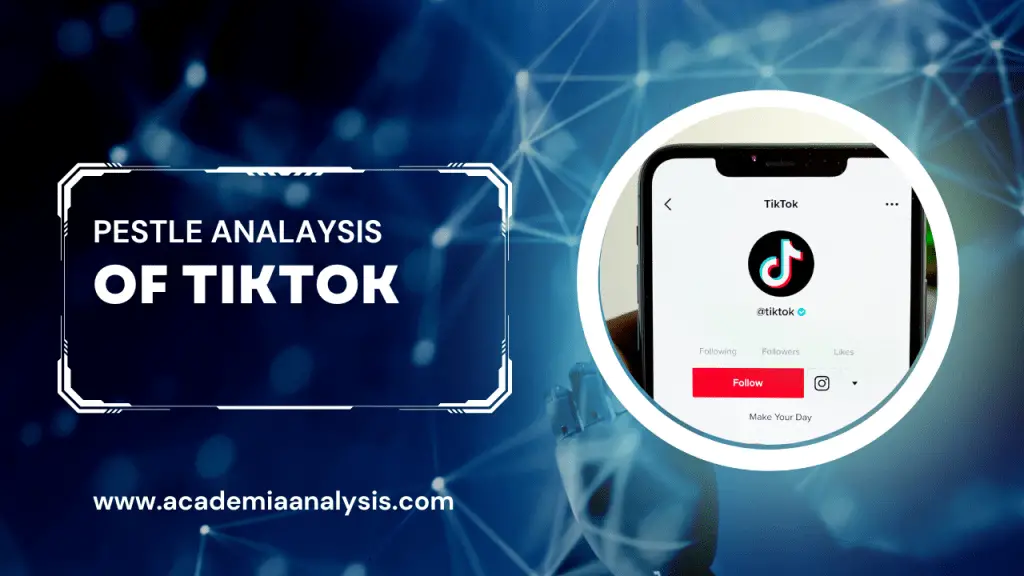Learn the main elements that make up the PESTLE analysis of TikTok and gain an understanding of how to craft your own.
Discover the external factors that impact this popular online social media.
PESTLE Analysis of TikTok – 6 Factors Analyzed
TikTok is a popular social media platform that has become a global sensation in recent years.
With its unique and engaging content, it has managed to capture the attention of millions of users worldwide, making it a valuable platform for businesses and individuals alike.
Like any other business or entity, TikTok is not immune to external factors that can impact its operations and success.

In order to gain a better understanding of the current and potential future challenges facing TikTok, a PESTLE analysis can be conducted.
This analysis will examine the political, economic, social, technological, legal, and environmental factors that could affect TikTok’s operations and growth in the future.
Political Factors
TikTok, a popular video-sharing social media app has been subject to various political factors that have influenced its operations and user base. Some of these political factors include:
- Government regulations: TikTok has faced regulatory challenges in several countries due to concerns about data privacy, censorship, and national security. For example, the app was temporarily banned in India in 2020 due to security concerns, and in the United States, the Trump administration attempted to force its sale to a US-based company.
- Nationalism: Some countries, such as India and China, have expressed concern about foreign influence on their domestic audiences through TikTok. As a result, there has been an emphasis on promoting local alternatives to TikTok, which has affected its user base.
- Geo-political tensions: Tensions between countries, such as the US and China, have also impacted TikTok’s operations. The Trump administration cited national security concerns when it tried to ban TikTok in the US, while China has accused the US of trying to suppress Chinese-owned technology companies.
- Election interference: TikTok has been accused of promoting political propaganda and misinformation during elections in some countries. This has led to increased scrutiny of the app’s content moderation practices.
- Advertising: Political campaigns have used TikTok as a platform to reach younger audiences during elections. For example, in the 2020 US presidential election, both Donald Trump and Joe Biden’s campaigns had a presence on TikTok, using the app to promote their respective messages.
These are just a few of the political factors that have affected TikTok. As the app continues to grow in popularity, it is likely to face further political scrutiny and challenges in the years ahead.
Economic Factors
The platform has had a significant impact on the economy, both in terms of its own revenue generation and the economic opportunities it creates for others. Here are some of the economic factors of TikTok:
- Advertising revenue: TikTok generates significant revenue from advertising. The platform offers various advertising options, including in-feed ads, brand takeovers, and sponsored challenges. TikTok’s advertising revenue is expected to reach $3.5 billion in 2021.
- Creator monetization: TikTok has a Creator Fund that pays eligible creators based on the views they receive on their videos. TikTok also allows creators to earn money through brand partnerships and sponsored content.
- Influencer marketing: TikTok has become a popular platform for influencer marketing, with brands paying popular TikTok creators to promote their products to their followers. This has created a new economic opportunity for influencers, who can earn significant income through sponsored posts.
- E-commerce: TikTok has started to experiment with e-commerce features, such as in-app shopping, allowing users to buy products directly from TikTok videos. This creates new opportunities for brands to sell their products and for creators to earn a commission on sales.
- App economy: TikTok’s popularity has led to the growth of an app economy, with developers creating third-party tools and services for TikTok users. This includes apps that help users edit their TikTok videos, track their analytics, and more.
TikTok has had a significant impact on the economy, both in terms of its own revenue generation and the opportunities it creates for others.
Social Factors
There are several social factors that contribute to its success and impact on society. Here are some of the main social factors of TikTok:
- Gen Z Culture: TikTok has been embraced by Generation Z, who are the largest demographic using the app. The app reflects the values and interests of Gen Z, with its focus on self-expression, authenticity, and humor.
- Creative Expression: TikTok is designed to encourage creative expression, allowing users to create short videos that showcase their talents, humor, and creativity. This has led to the emergence of new forms of content and creative expression, such as dance challenges, lip-syncing, and comedy skits.
- Influencer Culture: TikTok has given rise to a new generation of influencers, who have gained enormous followings by creating engaging and entertaining content. These influencers have become powerful cultural and social icons, shaping the tastes and preferences of millions of users.
- Globalization: TikTok has become a truly global platform, with users from all over the world creating and sharing content. This has facilitated cross-cultural communication and exchange and has helped to break down some of the barriers that have traditionally separated people from different parts of the world.
- Social Issues: TikTok has become a platform for discussing and raising awareness about social issues, such as mental health, body positivity, and social justice. This has allowed for new conversations and perspectives to emerge and has empowered users to speak out on issues that matter to them.
Technology Factors
TikTok is a social media app that has taken the world by storm, particularly among younger generations. Some of the key technology factors that have contributed to the success of TikTok include:
- Algorithmic feed: TikTok’s algorithmic feed is one of its biggest technological advantages. It uses machine learning algorithms to curate personalized content for each user based on their viewing history, engagement, and other factors. This means that users are constantly exposed to new and interesting content, keeping them engaged and coming back for more.
- Video editing tools: TikTok’s video editing tools are simple and intuitive, allowing users to create professional-looking videos with just a few taps. The app’s filters, effects, and music library make it easy for users to add their own personal touch to their videos.
- Short-form content: TikTok’s focus on short-form video content (15-60 seconds) makes it easy for users to consume and share content quickly. This is particularly appealing to younger generations, who have shorter attention spans and prefer quick, bite-sized content.
- Integration with other social media platforms: TikTok makes it easy for users to share their content on other social media platforms, such as Instagram and Twitter. This has helped to drive the app’s viral growth and increase its popularity.
- User-generated content: TikTok relies heavily on user-generated content, which has helped to build a strong sense of community among its users. This has also helped to keep content fresh and diverse, as users are constantly creating and sharing new content.
TikTok’s combination of algorithmic feed, video editing tools, short-form content, integration with other social media platforms, and user-generated content has made it a hugely popular app among younger generations.
Legal Factors
As a popular social media platform, TikTok is subject to various legal factors, including:
- Data Privacy: TikTok collects vast amounts of user data, including location, search history, and usage patterns. As such, the company must comply with various data privacy laws, such as the General Data Protection Regulation (GDPR) in Europe and the California Consumer Privacy Act (CCPA) in the United States.
- Copyright Infringement: TikTok allows users to upload and share content, including music and videos. As such, the company must ensure that user-generated content does not infringe upon the copyrights of others.
- Child Protection: TikTok has been criticized for its potential to expose children to inappropriate content and predators. As such, the company must comply with laws designed to protect children, such as the Children’s Online Privacy Protection Act (COPPA) in the United States.
- Intellectual Property: TikTok must also respect the intellectual property rights of others, including trademarks, patents, and copyrights.
- Advertising: TikTok generates revenue through advertising, and as such, must comply with various advertising regulations, such as truth-in-advertising laws and laws governing the use of children in advertising.
- Regulatory Compliance: TikTok must comply with various regulations governing the use of social media platforms, including laws governing political advertising and hate speech.
Note: It is important to note that the legal factors of TikTok may vary depending on the country or region in which it operates.
Environmental Factors
TikTok, like any other digital platform, operates within an ecosystem that includes various environmental factors that can have an impact on the app and its users. Some of the environmental factors that may affect TikTok are:
- Legal and regulatory environment: TikTok must comply with local laws and regulations in each country where it operates. For example, in the United States, the app faced a ban due to concerns over data privacy and security.
- Cultural environment: TikTok operates in a cultural environment that may have different social norms and values, which can impact the types of content that are acceptable or popular on the platform.
- Technological environment: The availability and accessibility of technology can impact the use and success of TikTok. For example, users may be more likely to use TikTok if they have high-speed internet and the latest mobile devices.
- Social environment: TikTok operates in a social environment that includes user behavior and interactions. Trends and challenges can quickly go viral, and user-generated content can spread rapidly through social networks.
- Environmental sustainability: TikTok, like any digital platform, has an impact on the environment through its energy consumption and data storage practices. As such, the app has been working to reduce its carbon footprint and implement more sustainable practices.
These environmental factors can influence TikTok’s popularity, user behavior, and impact on society and the environment.
Conclusion
TikTok has taken the world by storm, becoming one of the most popular social media platforms in a short time.
However, its success is not guaranteed, as it faces several external factors that could impact its future growth.
Using the PESTLE framework, we have analyzed TikTok’s political, economic, social, technological, legal, and environmental factors.
It is clear that the platform has numerous strengths, such as partnerships with brands and innovative technology, but it also faces challenges such as data privacy concerns and legal challenges.
In conclusion, TikTok must effectively manage these challenges, continue to innovate, and remain in tune with consumer preferences to remain successful in the future.
We hope now you may able to know how to do PESTLE Analysis of TikTok with less effort. Share with friends/colleagues if this helped you out.





